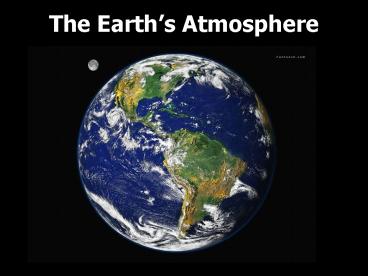The Earths Atmosphere - PowerPoint PPT Presentation
1 / 24
Title:
The Earths Atmosphere
Description:
carbon dioxide (.036%), methane (greenhouse gases) ... Loss of arable land (some areas hotter, others cooler) Extinction of thousands of species ... – PowerPoint PPT presentation
Number of Views:51
Avg rating:3.0/5.0
Title: The Earths Atmosphere
1
The Earths Atmosphere
2
The Modern Atmosphere (500 mya to the present)
- Nitrogen, N2 (78)
- Oxygen, O2 (21) 99.9
- Argon, Ar (0.9)
- Trace gases
- water vapor (0-4)
- carbon dioxide (.036), methane (greenhouse
gases) - nitrogen oxides, sulfur oxides (acid rain and
more) - many other trace gases
- particulate (dust)
3
Atmospheric Pressure
4
The Vertical Thermal Structure of the Atmosphere
5
Temperature Inversions
When warmer air overlies cooler air, pollutants
and fog are trapped beneath the inversion.
Common Winter Radiation Inversion in Valleys
6
Temperature Inversions
Common Summer Inversion in Los Angeles
7
The Importance of Stratospheric Ozone
- Ozone formed naturally in stratosphere (after
photosynthesis became common) - UV radiation (sun) --gt mutations
- plankton reduced (food chain base), crops decline
- weaker immune systems, skin cancer
- Stratospheric ozone (O3) absorbs UV rays
light
?
O2 ? 2 O then O O2 ? O3
8
The Importance of Stratospheric Ozone
- CFCs
- link to ozone hole established in 1970s
- Chloroflourocarbons (refrigerants, aerosols)
- one Cl can decompose more than 100,000 O3
- Montreal Protocol, 1987 U.N. agreement on ban
- up to 10 years for rising CFC gases to reach
stratosphere once in the stratosphere, CFCs can
last up to 50-100 years
9
NASA Ozone Watch Images Data Animations
10
Global Warming (Human-accelerated Greenhouse
Effect)
- The Greenhouse Effect
- Greenhouse Gases
- The Global Warming Hypothesis
- Observed Warming and Rising CO2
- The Effects of Global Warming
11
The Greenhouse Effect
Water Vapor Carbon Dioxide Methane
Greenhouse Gases
12
The Greenhouse Effect
- Keeps Earths average temperature 90º F warmer
(59º F 16 ºC average now) - Human role? A heated
debate
Venus 480ºC thick carbon
dioxide
Mars -62 ºC little carbon dioxide
13
Global Energy Balance
NO. Why not?
14
b
15
Global Surface Temperature Increase
16
Note that very recent rate of increase greatly
exceeds anything in last 1000 years.
17
650,000 years of climate and CO2
18
Changes in Solar Radiation
Milankovitch Cycles explain much (60) of the
changes
- 21,000 year cycle perihelion shifts throughout
the year - 41,000 year cycle /- 1.5 change in Earth's
tilt - 100,000 year cycle Orbital eccentricity of the
elliptical orbit of the Earth
The most recent ice age lasted 100, 000 years. We
are currently in an interglacial period
(Holocene).
19
Climate models suggest that the changes are just
beginning now and will accelerate.
20
The Global Warming Hypothesis
- Human-induced rise in CO2 levels is theorized to
lead to unnatural warming of atmosphere. - Likely effects
- Increased storminess
- Rising sea level (1-3 ft. in 100 years - IPCC,
2001) - Loss of arable land (some areas hotter, others
cooler) - Extinction of thousands of species
- Loss of nearly all coral reef
- Possible effects even include climate flip-flop
wherein dangerous rapid cooling sets in!
21
Warming of the climate system is unequivocal, as
is now evident from observations of increases in
global average air and ocean temperatures,
widespread melting of snow and ice, and rising
global mean sea level.
IPCC Report, 2007
22
So is Global Warming Really Happening? How much?
GLOBAL average temperatures will likely rise by
2.2-10F (1.4-5.8C) by the year 2100, according
to the most authoritative report yet produced by
the UN Intergovernmental Panel on Climate Change
(IPCC). These are massive increases over the .5C
rise seen over the last 100 years.
Source UN IPCC, 2001
23
So is sea level rise happening? How much?
GLOBAL average sea levels will likely rise by .5
- .9 meters (1.5 2.7 feet) by the year 2100,
according to the most authoritative report yet
produced by the UN Intergovernmental Panel on
Climate Change (IPCC). When added to storm surges
and high tides, these small changes may have
large effects.
Source UN IPCC, 2001
24
Where is CO2 released?
Total carbon release in metric tons, Source OECD































